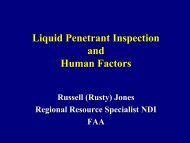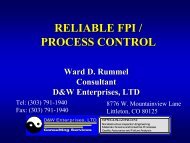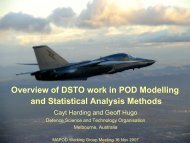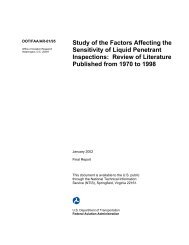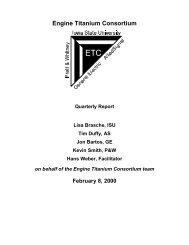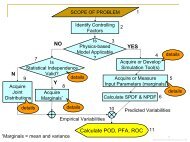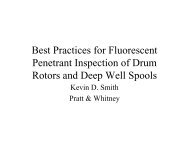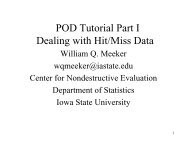Engine Titanium Consortium - Center for Nondestructive Evaluation ...
Engine Titanium Consortium - Center for Nondestructive Evaluation ...
Engine Titanium Consortium - Center for Nondestructive Evaluation ...
You also want an ePaper? Increase the reach of your titles
YUMPU automatically turns print PDFs into web optimized ePapers that Google loves.
Project 1:<br />
Task 1.2:<br />
Subtask 1.2.1:<br />
Production Inspection<br />
<strong>Titanium</strong> Billet Inspection<br />
Inspection Development <strong>for</strong><br />
<strong>Titanium</strong> Billet<br />
Team Members:<br />
HW: Andy Kinney, Waled Hassan<br />
ISU: Bruce Thompson, Ron Roberts, Frank<br />
Margetan<br />
GE: Dave Copley, Wei Li, Mike Keller, Jon<br />
Bartos, Richard Klaassen, John Halase<br />
PW: Kevin Smith, Jeff Umbach, Bob<br />
Goodwin, Andrei Degtyar, Harpreet Wasan<br />
Students: none<br />
Program initiation date: June 15, 1999<br />
Objectives:<br />
• To provide a procedure to account <strong>for</strong> attenuation effects such that the variation between<br />
calibration and inspection sensitivity is minimized.<br />
• To demonstrate the ultrasonic equipment and techniques required to inspect titanium alloy<br />
billets to #1FBH sensitivity <strong>for</strong> 10” diameter and below.<br />
• To provide an initial assessment of sensitivity at diameters greater that 10”.<br />
Approach:<br />
Transducer Design Models: The design models will be reevaluated in detail to determine reasons<br />
<strong>for</strong> discrepancies between predicted and measured transducer behavior observed during Phase I<br />
work. This reevaluation will focus initially on assessing how well the input parameters used <strong>for</strong> the<br />
models represent the physical behavior of the transducers. It is planned to begin with<br />
characterization of piezo-electric elements prior to the addition of backing materials, and then<br />
attempt to compare model predictions with experiment at subsequent stages of the manufacturing<br />
process. This will involve working closely with a transducer manufacturer with one potential source<br />
identified. Based on this exercise, modifications will be made to model input parameters or to the<br />
model code to improve the prediction accuracy. Attention will also be paid to selection of<br />
transducer materials with consistent and measurable properties, <strong>for</strong> example the machining of<br />
lenses from solid material rather than using cast-in-place epoxy. Results will be shared with<br />
transducer manufacturers to allow improvements in future products both <strong>for</strong> ETC and the broader<br />
ultrasonic transducer user community.<br />
Inspection of 10” Diameter Billet: Fixed focus inspection will be the primary technique in this task.<br />
If this approach proves inadequate to meet program objectives, viable phased array technologies<br />
will be reviewed to select a candidate technique with the most potential <strong>for</strong> meeting the program<br />
objectives in consultation with the FAA.<br />
Improved fixed focus transducers <strong>for</strong> 10” diameter billet will be designed. Results from Phase I<br />
measurements (at 2.25” and 4.05” depths) will be used to identify the best combination of focal spot<br />
Quarterly Report – January 1, 2002 –March 31, 2002<br />
print date/time: 6/6/2002 - 8:39 AM – Page 20



